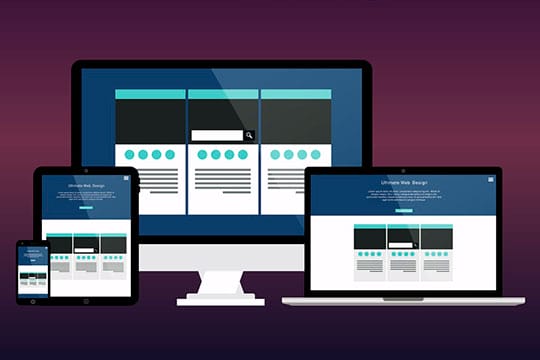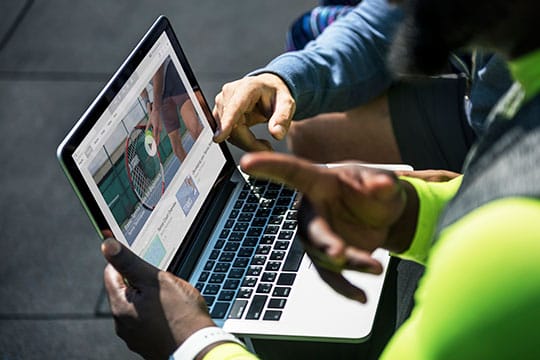Users visit plenty of websites daily, and companies must show extraordinary creativity to appeal to them. Small businesses should focus on some great visual appeals and efficacy of web solutions to make visitors stay on their website longer. However, it’s important to keep an eye on the latest web trends and use UI design patterns to remain on the top.
An effective website should achieve its intended purpose by passing on its message while engaging users. There are several factors that contribute to a good website design, including:
- Consistency.
- Imagery.
- Simplicity.
- Colors.
- Typography.
When designing a website, there are many key factors that will contribute to how it’s perceived. A greatly designed website will help you build trust and lead users to take action. Also, creating a good user experience includes making sure that your website design is optimized for usability, and how easy it functions. Below, we’ve gathered some guidelines that will help you with your next web design project.
1. Website purpose

Your website needs to put up with the needs of your visitors. Thus, you should create a simple and clear intention on your web pages to help the user interact best with what you have to offer. For example, you should add a “How to guide?” section to help users find the information they need. If you have an entertainment website that sells products to users, then you should use some essential purposes:
- Building your reputation.
- Generate leads.
- Describe expertise.
- Sales and aftercare.
A website’s purpose is to transform guests into predictions. A good way to start doing so is to determine what types of users are visiting your website, assess their requirements, and provide them good info about what to do next. First, create a website that attracts your audience’s attention. Businesses and people generally design web pages for different needs and purposes:
- Providing users with services and products.
- Gaining knowledge.
- Communicate with one another.
- Post and find information on the internet.
- Have fun.
Anyone can find a reason to design websites and sell products and services – These services or products could be free, but they could also help you make money.
Recommended for you: 9 Noteworthy Tips to Make Money as a Web Designer.
2. Ways to achieve simplicity

Simplicity is the greatest way to go when thinking about user’s experience and the usability of your web page. Simplicity is also one of the key reasons why some businesses do better than their competitors. Take as an example Apple iPhones, Google, WhatsApp, and so on: are just a few ways of the broadly popular products that display simplicity.
Simplicity can range nowadays – focusing on simplicity can be complex, but it’s worth it because once you’ll get there, you will be able to do everything. Here are some website design principles to consider to achieve simplicity:
Color

Color has the ability to communicate messages and suggest expressive responses. Find a color palette that suits your brand – it will allow you to influence your client’s behavior towards your business. But keep in mind that you should keep the color selection limited, as you shouldn’t use more than 5 colors. You could choose, for example, complementary colors – they work very well. Attractive color combinations will increase your customers’ engagement and make them feel good while visiting your website.
Typography

Typography plays an important role in designing a great website. Around 90% of the website is made out of typography. People visit websites to read content, therefore, how you choose to write on your website is crucial. Also, how you choose to present these words is equally important. Your website should be able to carry the commitment of the business to your online visitors. In today’s digital world, the simplest way to do it is through typography fonts.
Imagery

This is another important aspect when creating a website. Imagery includes photography, video, illustration, and forms of graphics. All imagery on your website should be easy-to-read and capture the spirit of the business. The imagery you’ll choose for your website is going to embody your brand’s personality. First impressions are important. Therefore, it’s important to choose high-quality imagery for your website so you can form a great impression of professionalism and trustworthiness in the user’s mind.
3. Website navigation

Navigation is the best way for users to find what they want on your website. Actually, website navigation is key in keeping your visitors as long as possible on your website. If the navigation will confuse your visitors, then they’ll probably go somewhere else to find what they need. Keep your navigation consistent, simple, and intuitive.
4. Stay mobile-friendly

As you may already have guessed, most people use their phones to browse the internet. So, it is incredibly important to consider creating your website with a quick responsive design and adjust it to different screens. A traditional website is designed for desktop, but this will make you lose valuable visitors and potential clients. It’s time to optimize your website and make it mobile-friendly to win back those lost clients.
You may like: Top 10 Best Selling Web Design Books for Easy Learning.
5. Visual hierarchy

Visual hierarchy refers to the arrangement of elements in order of rank. This could be done by size, color, contrast, imagery, typography, texture, style, and whitespace. The most critical function of visual hierarchy is to choose focal points and show visitors the important information.
6. Content

Needless to say, an effective website will also need to have great content. We’ve all heard that content is key to an effective and successful website – but content cannot build itself and bring a digital plan to life. Some web design principles are needed, such as:
- Design.
- User experience.
- Development.
- Copywriting.
- SEO (search engine optimization).
- Marketing.
- Public relations.
- Brand Building.
- Information architecture.
For most businesses and brands, creating a successful website isn’t easy or quick. It will take patience, time, and resources. Remember that optimizing your website isn’t always just SEO. It’s important to understand that you must consider a lot more aspects to define your website over time.
7. Communication

The primary reason why users access a certain website is to get information. If your website isn’t able to communicate with your visitors efficiently, they will probably choose to spend more time on other websites. Communication is one of the initial elements of a good web design. It’s essential for providing your users a positive experience and for a successful website that really profits its owners. Many types of websites are affected by the need for great communication, somehow. No matter the type of website, there is a great need to communicate effectively with users.
Therefore, every website owner should take into consideration the responsibility of good communication on their website. Unfortunately, communication is often seen as a non-important factor in the visual appeal of a website. But it is ideal to consider giving a clear and unified message to your users.
Websites communicate with users in many different ways. Not all websites take the exact same approach, but almost any website owner should look at the following few common methods of communication.
The common methods of communication:
- Images.
- Text.
- Titles and Headers.
- Icons.
- Design styles.
- Audio.
- Video.
In order to create a website effectively and clearly communicate with users, challenges might be encountered. Not all web designs are the same, so it may differ from one website to another how the messages are provided to visitors.
What challenges web designers have to overcome often? They must decide on the amount of content and information they use on their websites. Having lots of quality info is a great thing, but it can also be difficult to communicate clearly with users. In some cases, web pages with less, but qualitative content have an easier time effectively communicate with users.
Trying to fit a lot of content on a web page cannot but create a cluttered website, which is confusing for users. A busy and cluttered web page can often send unclear messages, which is exactly the opposite of what you want your users to receive when visiting your website. Every visitor is different, so it will be impossible to classify them into one group. Thus, you should design a website that targets the audience in mind: it means that diversity should exist.
You may also like: SEO and Web Design: How to Make Sure They Go Hand in Hand?.
What do users think?

So, users’ habits on the internet aren’t different from customers who go to physical stores. Visitors look at every new page, read some of the content, and click on the first web page they find interesting. Actually, there are large parts of the web page they don’t even take a look at. Most of the users will search for something interesting and clickable, so if your website doesn’t meet users’ needs or expectations, the “Back” button will be clicked instantly.
So, what do users appreciate most in a website?
- Quality.
- Credibility.
- Anchors that will guide them through the content of the page.
- Up-to-date websites.
- Easy navigation.
- Relevant content.
- Product descriptions.
- Company blogs (50% of users think it’s useful).
It’s simple: people want to limit their time online, which requires all businesses to develop more engaging websites.





